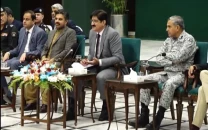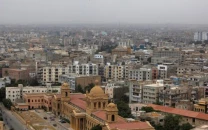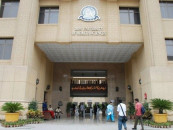‘Information and computational sciences create inclusive society’
According to Sukkur IBA dean, modern tools are outcome of innovations in various fields

Math, everywhere: The ICCMS endeavoured to provide a forum and interdisciplinary platform for discussion on contributions to recent technological advances, innovations and experiences in the area of computing and mathematical sciences. PHOTO: COURTESY SUKKUR IBA
He was delivering a welcome address to the participants of the International Conference on Computing and Mathematical Sciences (ICCMS) on Saturday.
According to him, the modern tools and techniques that are used to solve complex problems of the world we are living in are the outcome of advances and innovations in various fields, in which mathematical science remains at the core of all computing developments and advancements. He appreciated the efforts of the team of ICCMS for organising the conference at Sukkur IBA. "We are keen to learn new developments and innovation in the field of computer sciences and mathematics by these renowned speakers," he added.
The ICCMS 2017 endeavoured to provide a forum and interdisciplinary platform for researchers, scientists, practitioners, academicians and students to present and discuss their contributions to the recent technological advances, innovations and experiences in the area of computing and mathematical sciences.
The theme of the conference was ‘Invent, Innovate, and Integrate for Socioeconomic Development’. Specifically, the conference focused on all the areas of software engineering, computer communication and networks, social networking and data sciences, ubiquitous computing, soft computing, applied mathematical analysis, mathematical finance, algebra, geometry, statistics and stochastic processes.
Further, the conference emphasised the importance of innovations, inventions and integration to improve the quality of different stakeholders of society through the use of computational technologies for socioeconomic development. Researchers from different countries, including United States of America, United Kingdom, Italy, Korea, Malaysia, Oman, Pakistan, Saudi Arabia and Sudan submitted 143 papers covering various domains of computing and mathematics. A total of 66 papers were accepted for presentation and publication in the conference proceedings after a comprehensive review process. Renowned international and national reviewers took part in the selection process.
Key note speaker Prof M Tahar Kechadi of University College Dublin in Belfield talked about ‘Privacy-Aware Data Analysis in Healthcare Data Records’. "Turning this massive amount of data into knowledge that can be used to identify needs, predict and prevent critical patients' conditions and help practitioners to make rapid and accurate decisions is not only a desire but is an urgent and crucial necessity," he said.
Dr AM Siddiqui from Pennsylvania State University talked about the topic of modelling of fluid flow in the human body from the hydrodynamics point of view. He mainly focused on two areas of modelling: the peristaltic motion and the fluid flow in the human kidney.
Another keynote speaker, Prof Dr Zubair A Shaikh, the president of Muhammad Ali Jinnah University, Karachi, talked about the recent computing trends in relation with some of the greatest humanitarian and social challenges.
Prof Dr Mohamed Ridza Wahiddin of the International Islamic University, Malaysia, talked about ‘Harnessing the Vacuum for Quantum Computing’. “These are responsible for many interesting effects in quantum optics (where light and matter are both treated as quantum objects), such as spontaneous emissions, which, in turn, trigger lasers,” he said. “We may even squeeze a vacuum so that it modifies fluorescence and absorption spectra resulting.”


















COMMENTS
Comments are moderated and generally will be posted if they are on-topic and not abusive.
For more information, please see our Comments FAQ